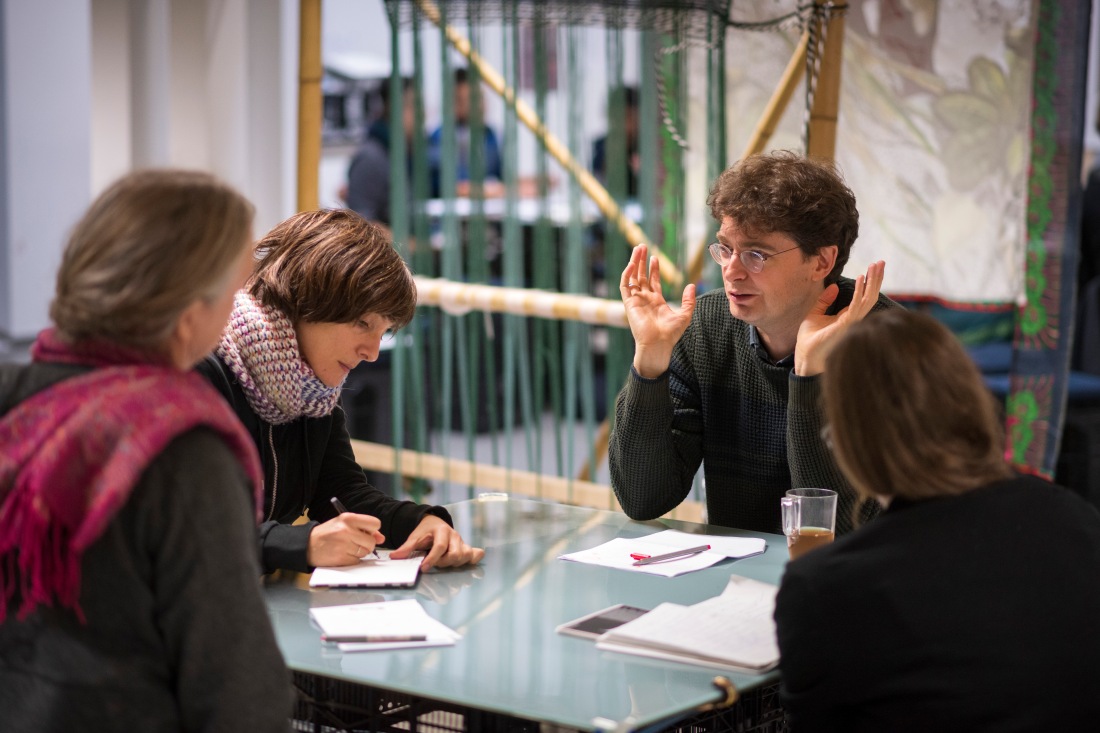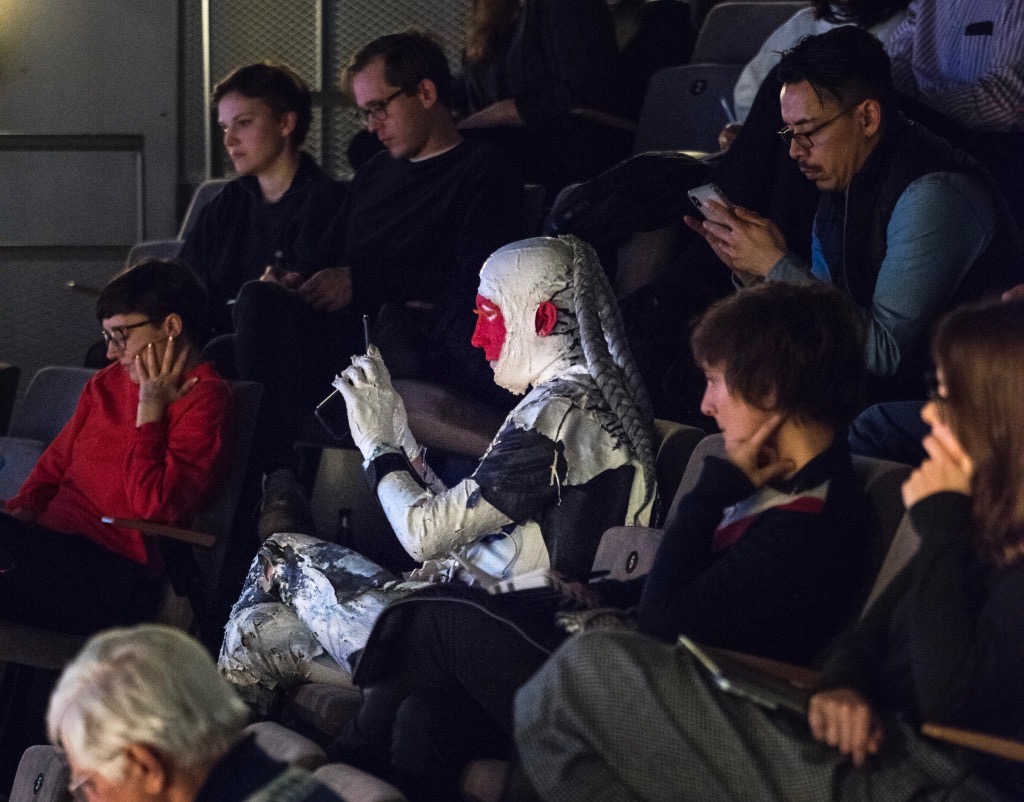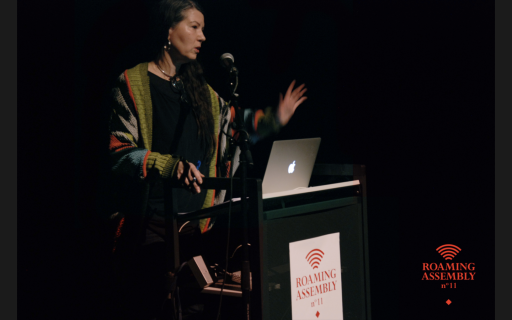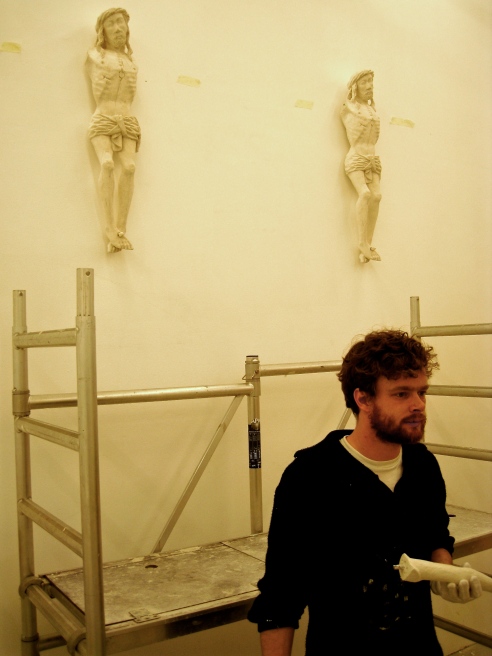2019: Deserting from the Culture Wars
Trainings, lectures, and panel discussions with Bini Adamczak, Kader Attia, Tom Holert, Diana McCarty, Dan McQuillan, Dina Mohamed, Jonas Staal, Johannes Paul Raether, Rose Hammer (Stacey E. Devoe, Dora Garcia, Nora Joung, Per-Oskar Leu, and Niels Munk Plum), Natascha Sadr Haghighian and Terra Critica (Birgit M. Kaiser and Kathrin Thiele).


Propositions #9: Deserting from the Culture Wars was a week-long series of trainings, lectures, and panel discussions at BAK in Utrecht, as a kind of spin-off from Jeanne van Heeswijk’s project Trainings for the Not-Yet at this institution. Deserting from the Culture Wars brought together artists, theorists, and writers to work towards a tactical desertion from the cultural conflicts being waged today in a theater of war, demarcated by the (far-) right through aggressive hypersensitivity, injured entitlement, angry rants, and memes about “cultural Marxism,” immigration, climate change, and feminism. What possibilities would be opened by a refusal to play these war games, and commit desertion—not as a withdrawal into a realm of apolitical privacy, but as a pursuit of different strategies, tactics, and coalitions?


Rather than being merely an object of debate, an emancipatory understanding of culture is to be conceived as embodied and intersubjective, a collective performance that prevents culture from becoming a self-congratulatory exercise among like minds, but marks instead a space of enactment. How to widen this further and create overlaps and alliances? What might artists and others who are professionally engaged with images and imaginaries, narratives and assemblies, have to contribute to the collective discovery of different modes of culture?



2017: The Strange Case of the Case

This symposium was part of the Dutch Art Institute’s Roaming Assembly series and took place on Sunday, February 12, 2017. The theatre Huis Oostpool in Arnhem became a meta-court in which artists and art historians discussed and (re)enacted legal cases. As ways of reshaping the sensible and the social, juridical and aesthetic practice and theory have a complex and fraught relationship that is at the basis of Sven Lütticken’s DAI theory seminar Legalize Everything, which deals with the purchase the “real abstractions” of the law have on ever more sectors of society and aspects of life; we are in the midst of a progressive “legalization”—in the sense of its incorporation of art, among other disciplines, to the sphere of the juridical. It is in courts that the productivity and operationality of legal abstraction becomes fully apparent: here the world is remade on a case-by-case basis. If, for Cicero, actors merely mimic the real while (legal) orators act the real, this distinction is far from clear-cut. Even while the juridical seeks to regulate art and fully subject the aesthetic to the productive logic of (intellectual property) law, the court case as legal theater can be subject to unscripted interventions by various players.
Zachary Formwalt; Night of January 16th: A counter-play. Performance with DAI students Mira Adoumier, Astarti Athanasiadou, Ulufer Celik, Agata Cieslak, Benedicte Clementsen, Giulia Crispiani, Valentina Curandi, Iva Kovac, Aldo Ramos, Despina Sevasti, Savannah Theis and Wilfred Tomescu

“We are turning towards (….) a nineteenth century United States Supreme Court case that would prove foundational in the establishment of corporate personality as it is understood today in the United States. We’re going to stage the filming of the testimony in question as a series of screen tests. There are some prepared answers to some prepared questions. A lawyer should never ask a question to which s/he doesn’t know the answer, as the saying goes. Since we are not lawyers, there will hopefully also be some unprepared questions.”
Frederic J. Schwartz, “Brecht’s Threepenny Lawsuit and the Culture of the Case.” Lecture.

‘Brecht was a connoisseur of the legal case. From his essay on the Threepenny Lawsuit to many dramatic scenes of courts or tribunals, he showed a longstanding fascination with legal process. Yet while the Threepenny Lawsuit is a touchstone for critical discussions of modern media, it remains relatively little studied as a reflection on the law and as an intervention into contemporary discussions of it. This paper asks why, and seeks an answer by looking first at legal proceedings as a medium, and second at the media of the law.”
Judy Radul, Body Press to Body Cam: Video in Art and Court. Lecture.

Agency: Assembly (The Strange Case of the Case), lecture performance

“For Assembly (The Strange Case of the Case), Agency calls forth one “thing” from its “list”, speculating on the question: ‘What if “objective” things become mutually included within artistic practices?’ Copyright protects original and not common ‘works’. Thing 001029 (Letty Lynton) will convene an assembly at DAI in order to bear witness. It concerns a controversy between the theater makers Edward Sheldon and Margaret Ayer Barnes and the film studio Metro-Goldwyn-Mayer about the film Letty Lynton. During the 1936 court case Sheldon and Barnes v. Metro-Goldwyn-Mayer at the Court of Appeal in London Judge Hand had to decide if the film Letty Lynton used the judgment of the Madeleine Smith criminal trial in Scotland in the public domain or the script of the play Dishonored Lady, which was based on that criminal trial, by Sheldon and Barnes.”
2013: This Is Television (video programme in Judy Radul’s exhibition)
Judy Radul’s 2013 exhibition This Is Television at the daadgalerie in Berlin encompassed a 16 mm film, video stills and a set-up of monitors and cameras for which I compiled a video programme that contains artistic reflections on the medium as well as direct interventions in broadcast or cable television. Visitors could see the actual videos on one of three monitors, but their pacing was used by Judy to manipulate a local television feed through the intermediary of two live cameras; the results were shown on the other two monitors in the space.
2012: A Movie Will Be Shown Without the Picture
On 12 June 2012, Louise Lawler’s A Movie Will Be Shown Without the Picture was non-screened at The Movies in Amsterdam. In the case of the original 1979 version at the Aero Theater in Santa Monica and in some later iterations of the piece, the movie shown was The Misfits (1961); in 1983 in New York, it was The Hustler (also 1961), preceded by the Chuck Jones cartoon What’s Opera, Doc? In 2012, the film selection has progressed to the late 1970s: as most audience members will have realized instantly upon hearing the first notes of the soundtrack in the darkened theater, this time the film was Saturday Night Fever (1977).
The piece’s anachronistic update was one subject of the conversation that I moderated afterwards (in the cinema’s café) with Eric de Bruyn and Andrea Fraser—with Louise herself in the position of “fact checker.” Moving from the dying days of Old Hollywood to a rather remarkable hybrid of gritty 1970s urban drama and neo-“cinema of attractions” blockbuster spectacle that is almost contemporaneous with A Movie will be Shown Without the Picture itself, Lawler gave us much food for thought.
As Andrea rightly stressed, Saturday Night Fever teems with metaphors of psychological and social projection, and it brings a new form of precarious masculine performance into play. Meanwhile, what was noticeable across a range of audience reactions—from audible snoring, relaxed beer-drinking and talking to smartphone use—was the way in which the non-picture foregrounds audience performance. Andrea once remarked that you don’t simply look at a work by Lawler: you are addressed and interpellated by it. A Movie spawns forms of audience performance without making grand claims about activating or emancipating the spectator.
While the work can obviously related back to various avant-garde attacks on the cinema and the filmic image, as a performative intervention in the cinematic apparatus it can also function as an anticipatory critique of much later relational and “social” art practice. Hollywood producer Samuel Goldwyn allegedly once bowed out of a project with the malapropism “Include me out!”, and the paradoxical effect of A Movie Will Be Shown Without the Picture is that it does indeed include the spectator out. Or does it exclude her in? If, referencing Louise’s phrase Why Picture’s Now?, we ask “Why A Movie Without the Picture now?”, this gently insidious quality would certainly have to be part of the answer.
Eric raised the issue of the term picture itself, which is obviously both very specific and heavily connoted in the context of late-1970s art practice. Why the “picture” (as opposed to, say “image”) in A Movie Will Be Shown Without the Picture? We did not get around to fully addressing this, and as usual a lot of loose ends remained. I will continue to work on this piece and the aim is to end this “Performance in Residence” project with a small publication. Many thanks to Louise, Andrea, Eric, Frederique Bergholtz, Tanja Baudoin, Ann Goldstein and the Stedelijk staff members and everybody else who made this possible—including the audience members.
A book on A Movie was published by If I Can’t Dance in early 2015.
2011-13: Séances (with Eric de Bruyn)
Séances was the title of a 2011 seminar I taught jointly with Eric de Bruyn at both VU University Amsterdam and the University of Leiden. Séances took its name from the French term for film screening—une séance de cinéma. Contemporary artists frequently organize screenings of films or compose film programs, either in art spaces or in cinemas (often in conjunction with one of their exhibitions). The practice has become so established that it seems to have become one more tool in the contemporary artist’s toolkit, albeit not always used with great discrimination.
However, the more interesting examples can also be seen as reflections on the screening session as a medium, or rather as a model of artistic practice that tries to go beyond dominant and oft-criticized forms of movie consumption. The screening event can be a performative exploration of alternative modes of mediation, operating directly on the present by reworking the past in an attempt to foster different relationships between audience and screen.
In 2012, we pursued the project with a screening series at the MUMOK, with reenactments of historical séances and screenings by Albert Oehlen and Christopher Williams, Paul Chan, Wendelien van Oldenborgh and Eva Meyer and Eran Schaerf. In April 2013, Eric co-organized a Séances conference at Columbia University and Light Industry in New york, at which I gave a talk on Louise Lawler’s A Movie Will Be Shown Without the Picture and introduced a repeat of Paul Chan’s film programme from the MUMOK, What Can 1 Know? What Ought 2 Do? What May 3 Hope For?, which didn’t manage to chase away quite as many audience members as it had done in Vienna.
2012: The Imaginary Museum (curated by Bart van der Heide)
When Krijn de Koning had an exhibition at the Musée des Moulages in Lyon, I wrote an essay for an accompanying publication that never saw the light of day. In 2012, Bart van der Heide of the Kunstverein München used this text, “The Imaginary Museum of Plaster Casts,” as point of departure for his show The Imaginary Museum. Before the war, Munich’s collection of plaster casts after antique statues used to be on display in the spaces along the Hofgarten that now house the Kunstverein; Bart is reconstructing one of these spaces and combines the casts with photo and video works by contemporary artists.
My essay relates the phenomenon of the plaster cast collection to Malraux’s notion of the musée imaginaire constituted by photography (Malraux himself already made this comparison, but I develop the point). I reworked the text extensively for the Kunstverein’s newsletter, including a discussion of contemporary artistic practices that were absent from the original version, such as Arnoud Holleman and Gert Jan Kocken’s, as well as Sean Snyder’s Index project. The latter was also featured in the exhibition. In some ways, the essay is a pendant of the “Viewing Copies” article, and both are part of the research project on objecthood and thingness, titled (tentatively) Obstructions.
2008-09: The Art of Iconoclasm
Artists: Carl Andre, Carel Blotkamp, Guy Debord/Jean-Léon Gérôme, Rod Dickinson & Tom McCarthy, Hans Haacke, Arnoud Holleman, Imi Knoebel, Gert Jan Kocken, Krijn de Koning, Willem Oorebeek, Natascha Sadr Haghighian, Haim Steinbach, Rosemarie Trockel, and Lidwien van de Ven.
The Art of Iconoclasm was the exhibition part of a project I conceived for BAK, The Return of Religion and Other Myths, which was related to my book Idols of the Market. The Return of Religion and Other Myths also included a series of lectures and presentations in early 2009, with speakers ranging from theorists such as Jan Assmann, Silvia Naef and Marc De Kesel to some of the artists in the exhibition. Their contributions, as well as other texts, formed the basis of a reader that was published later that year.
The project started from the supposition that the news of God’s death appears to have been premature. Religion is everywhere in contemporary politics and in the media; it has returned on the scene as a politicized media phenomenon creating controversies around righteous beliefs and their images. Religion is increasingly a matter of media controversy, of “image wars,” rather than daily observance or sophisticated theology.
In a way, this development can be understood as consequential: monotheism was always deeply concerned with appearances, with images—after all, it was defined by the rejection of idols. In many religious teachings false gods, worshipped in the guise of “graven images,” are defined in visual terms. In the Christian tradition, the Second Commandment dictates that of the true God no images must be made. Visibility is the realm of the false gods. The Christian doctrine of the incarnation further mitigated this ban on representing God, since in Jesus God had taken on the form of a mortal man; however, the representation of Christ remained potentially contentious, as various episodes of iconoclasm show. On the other hand, while Islam is exceedingly strict in its ban on images (tasweer) that may lead to the idolatrous “association” (shirk) of other deities with Allah, it also has a history of depictions of the Prophet, including a still-living tradition of popular images in Shiite Islam. As much as demagogues would like us to believe otherwise, no religion is monolithic, and nothing is more unstable and contested than the definition of idolatry.
In refusing to regard iconoclasm merely as a pathological phenomenon associated with the religious other, this exhibition offered a counter-myth of iconoclasm. If both the narrative of secularization and that of the return of religion can be characterized as myths, this does not mean that they are simply untrue; according to a contemporary understanding of the term, myths are not just imaginary stories, but narratives that give historical events a contemporary meaning and can thereby, to some extent, shape reality. Rather than as “iconophobic” vandalism, iconoclasm at its most interesting can be seen as an attempt to redefine and re-imagine the image and to question what passes for visual culture—a culture whose images, including the images of religious confrontations that we are fed on a daily basis, may in fact be insufficiently visual. Do they not seem to be designed to obscure rather than reveal those processes that engender hatred and justify violence?
In seeking to go “beyond the image wars,” the 2002 exhibition Iconoclash: Beyond the Image Wars in Science, Religion and Art at ZKM (Zentrum für Kunst und Medientechnologie) in Karlsruhe disparaged iconoclasm as such in favor of an “iconoclash” that amounts to a questioning and examination of images that suspends the urge to smash them. However, iconoclasm was always more than mere image-smashing, and amidst today’s spectacular battle over images it is crucial to reclaim iconoclasm—and religion—from its fundamentalist appropriators. As a criticism of images, the monotheistic discourse on idolatry also paved the way for modern critiques—of tradition, of religion itself, of the commodity, and of capitalism. Regarding religious criticism and secular critique as being of the same ilk, Iconoclash co-curator sociologist Bruno Latour goes so far as to say that “suspicion has rendered us dumb.” Governments from Washington to Teheran must rejoice at such prose. The efficacy of critique in the face of terror and counter-terror is indeed doubtful, but rather than a disparagement of it as such, what is needed is a reexamination of our cultural and political deadlock, in which critique is either institutionalized and neutralized, or equated with dangerous political dissent and terrorism.
The exhibition was conceived as a three-dimensional essay in two parts, which stages a confrontation between various kinds of iconoclasm in order to chart the (im)possibilities of contemporary iconoclasm in art, theory, and cultural and political practice in general. It consisted of two parts:
Part 1: From Idol to Artwork (BAK)
While iconoclasm is often equated with the destruction of art, it has, more interestingly, produced art. This part of the exhibition reflects on this process and on its consequences. Iconoclastic erasures can even come to function as an integral part of an artwork. Furthermore, the critique of cult images as idols stimulates their recontextualization as art: after centuries of neglect, from the Renaissance onward Apollo finds a new home in the museum, as fallen idols are reborn as art. By questioning cult images and removing them from their sacred context, monotheism facilitated their eventual transformation into objets d’art with a secularized aura. Certain objects associated with monotheism—medieval Madonnas, Persian illuminations—even came to be regarded primarily as priceless works of art. In the museum, one could say that Christ, Buddha, and Muhammad exist on the same abstract plane (even if didactic wall texts or visitor guides may treat them differently). At the same time, some critics have argued that the work of art remains ever in the service of “cult value.” Marx’s concept of the commodity fetish was based in part on eighteenth-century writer Charles De Brosses’ notion of African fetishism, which in his view was a worship of random objects that constituted a “primitive” prelude to idolatry; as the commodity fetish par excellence, is the modern artwork not just a barely secularized idol? If we look to the recent history of modern art, iconoclastic attacks on Greek and Roman idols-turned-art and the critique of representation in general led—among other things—to abstract paintings that seem to obey a secular Second Commandment, banning representation not because of a religious dogma, but as a consequence of a critique of art and its conditions.
Even if artists such as Piet Mondrian had long abandoned the faith in which they were raised by the time they made their mature work, this rejection of representation mirrors the old monotheistic condemnation of idolatry, which has become an integral part of modern critical thought. In the current context, however, abstraction often comes to be associated with Islam: think for example of last year, when Cologne’s Cardinal Meisner complained that Gerhard Richter’s new abstract stained-glass window for his cathedral would be better suited for a mosque, or how full-body veils are seen by some as symptomatic of Islam’s abstract rejection of western “visual culture.” But then, is the “spectacle” of our media-saturated society not itself abstract to the core, programmed as it is by digital codes? Just how visible is the logic underpinning our “visual culture”? Such were the questions that part 1 sought to articulate, with work by artists including Carl Andre, Krijn de Koning, Haim Steinbach, Rosemarie Trockel and Lidwien van de Ven.
Part 2: Attacking the Spectacle (CM Studio)
The second part of the exhibition, Attacking the Spectacle, focuses on the political contestations of what Antonio Negri and Michael Hardt have characterized as the “Empire” of global capitalism. Here again the religious and the secular are in dialogue with each other. Modern theory and activism contain secularized traces of the Christian attack on Roman spectacles. For the early Christians, the Roman Empire was the paradigmatic idolatrous society. The early Christian rejection of spectacles remained a potent trope in western culture, ready to be reactivated, for instance by Enlightenment philosopher Jean-Jacques Rousseau. This “anti-spectacular” discourse was transformed and radicalized by modern theorists and artists; building on Marx’s analysis of commodity fetishism for example, filmmaker and theorist Guy Debord attacked capitalism as a “society of the spectacle” whose images barely disguised that it is a system of exploitation and living death.
Such critics may be truer descendants of monotheistic thinking than current fundamentalist terrorists who seem to outdo each other in the embrace of today’s spectacle of the media, and whose strategies are shaped by modern terrorism. Rather than resolutely rejecting the capitalist spectacle, fundamentalists transform it into a spectacle of their own, dominated by dualistic clashes between good and evil and effects-laden scenes, of which the images from 9/11 are the most famous example. How can we imagine forms of theory and practice that break the deadlock created by the war of images and counter-images, of terror and counter-terror? Artists in this section included Guy Debord, Hans Haacke, Rod Dickinson, Willem Oorebeek and Natscha Sadr Haghighian.
2005: Life, Once More: Forms of Reenactment in Contemporary Art
Participating artists: Mike Bidlo, Bik Van der Pol, Rod Dickinson, Omer Fast, Andrea Fraser, Robert Longo, Eran Schaerf, Catherine Sullivan, and Barbara Visser.
Life, Once More presented artistic approaches to reenactment, in particular new versions of performances by artists from the 1950s and 1960s, in the context of popular historical (war) reenactments—that contemporary form of historicism in action, in which the works in the exhibition intervene in one way or another.
Jackson Pollock already had the feeling that his existential “act” for the painting session filmed by Hans Namuth degenerated into “acting“ in the sense of theatrical performance – something he found insufferable. His filmed act has since been reenacted, in the film Pollock as well as by artists. In the realm of reenactment, media images and live performance are inextricably entangled. This is true as well for reenactments outside the art context. Fanatical hobby reenactors, who stage World War I or World War II Battles, are often critical of Hollywood’s depictions of history and of media representations in general. However, not only do reenactors make photos and videos during their staged battles, and appear as extras in Hollywood films, they are also thoroughly influenced by the films they watch. In an attempt to fight repetition with repetition, to break open and activate the past, Life, One More couples examples of artistic reflection on such historical reenactments with (registrations of) reenactments of performances.
The exhibition took up the top floor of Witte de With. While the works to the left of the entrance/staircase engaged in a dialogue with this most visible form of reenactment, those on the right-hand side reenacted performances (though not always “official” art performances) by artists from the past few decades. This, to be sure, is just a rough and insufficient division; the interplay between the various pieces was not necessarily limited to this. A central corridor cutting through both parts contained photographs, single-channel videos and a video game as documentary supplements.
The accompanying publication contains texts by Jennifer Allen, Peggy Phelan, Eran Schaerf, Barbara Visser and myself. For more on the exhibition and the participating artists, see http://www.wdw.nl/project.php?id=36
Images: installation view of Bik Van der Pol, Past Imperfect (2005); installation view of Eran Schaerf, Scenario Data # 39 (2005).










